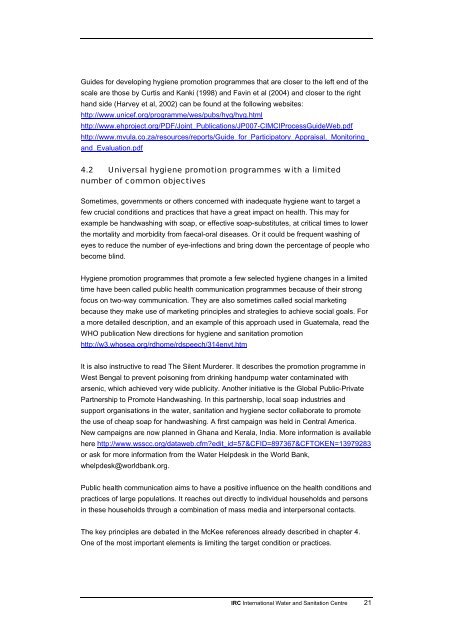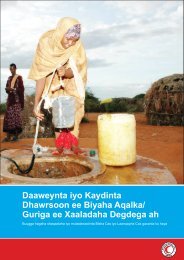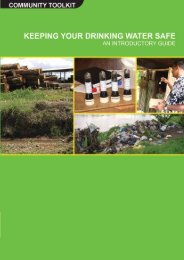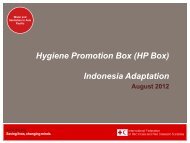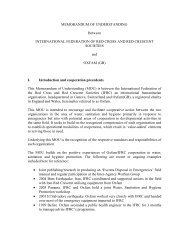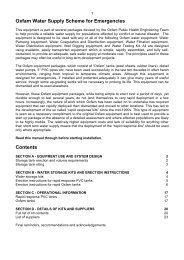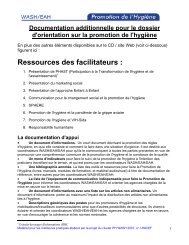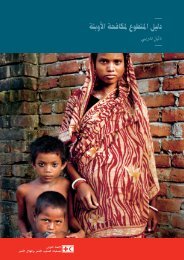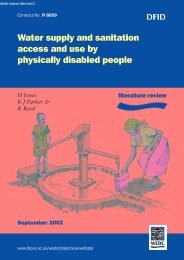Hygiene Promotion - IRC International Water and Sanitation Centre
Hygiene Promotion - IRC International Water and Sanitation Centre
Hygiene Promotion - IRC International Water and Sanitation Centre
Create successful ePaper yourself
Turn your PDF publications into a flip-book with our unique Google optimized e-Paper software.
Guides for developing hygiene promotion programmes that are closer to the left end of thescale are those by Curtis <strong>and</strong> Kanki (1998) <strong>and</strong> Favin et al (2004) <strong>and</strong> closer to the righth<strong>and</strong> side (Harvey et al, 2002) can be found at the following websites:http://www.unicef.org/programme/wes/pubs/hyg/hyg.htmlhttp://www.ehproject.org/PDF/Joint_Publications/JP007-CIMCIProcessGuideWeb.pdfhttp://www.mvula.co.za/resources/reports/Guide_for_Participatory_Appraisal,_Monitoring_<strong>and</strong>_Evaluation.pdf4.2 Universal hygiene promotion programmes with a limitednumber of common objectivesSometimes, governments or others concerned with inadequate hygiene want to target afew crucial conditions <strong>and</strong> practices that have a great impact on health. This may forexample be h<strong>and</strong>washing with soap, or effective soap-substitutes, at critical times to lowerthe mortality <strong>and</strong> morbidity from faecal-oral diseases. Or it could be frequent washing ofeyes to reduce the number of eye-infections <strong>and</strong> bring down the percentage of people whobecome blind.<strong>Hygiene</strong> promotion programmes that promote a few selected hygiene changes in a limitedtime have been called public health communication programmes because of their strongfocus on two-way communication. They are also sometimes called social marketingbecause they make use of marketing principles <strong>and</strong> strategies to achieve social goals. Fora more detailed description, <strong>and</strong> an example of this approach used in Guatemala, read theWHO publication New directions for hygiene <strong>and</strong> sanitation promotionhttp://w3.whosea.org/rdhome/rdspeech/314envt.htmIt is also instructive to read The Silent Murderer. It describes the promotion programme inWest Bengal to prevent poisoning from drinking h<strong>and</strong>pump water contaminated witharsenic, which achieved very wide publicity. Another initiative is the Global Public-PrivatePartnership to Promote H<strong>and</strong>washing. In this partnership, local soap industries <strong>and</strong>support organisations in the water, sanitation <strong>and</strong> hygiene sector collaborate to promotethe use of cheap soap for h<strong>and</strong>washing. A first campaign was held in Central America.New campaigns are now planned in Ghana <strong>and</strong> Kerala, India. More information is availablehere http://www.wsscc.org/dataweb.cfm?edit_id=57&CFID=897367&CFTOKEN=13979283or ask for more information from the <strong>Water</strong> Helpdesk in the World Bank,whelpdesk@worldbank.org.Public health communication aims to have a positive influence on the health conditions <strong>and</strong>practices of large populations. It reaches out directly to individual households <strong>and</strong> personsin these households through a combination of mass media <strong>and</strong> interpersonal contacts.The key principles are debated in the McKee references already described in chapter 4.One of the most important elements is limiting the target condition or practices.<strong>IRC</strong> <strong>International</strong> <strong>Water</strong> <strong>and</strong> <strong>Sanitation</strong> <strong>Centre</strong> 21


